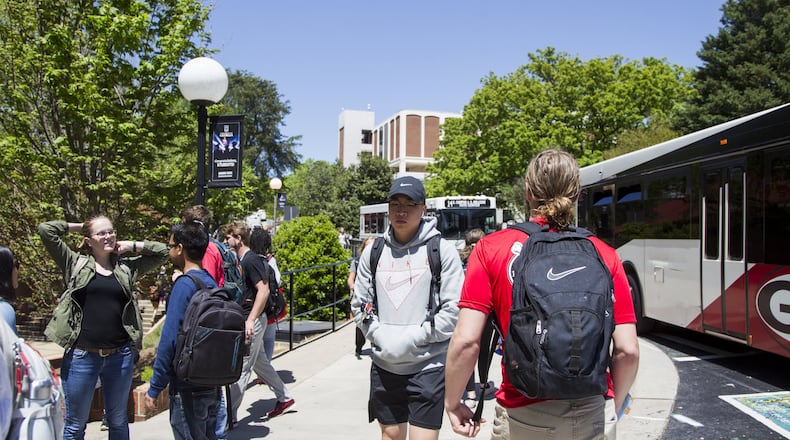Leslie De Santos furrowed her brow as she read the passage.
The four sentences contained terms such as “litigation,” “adjudicative,” “jurisdiction” and “identifiers,” and the last sentence, 23 words long, included two semicolons.
It wasn’t an assignment from an advanced course in legal studies. The passage was from the free application for federal student aid, otherwise known as FAFSA, an integral — and often hated — part of the lives of high school seniors who aspire to college.
Cluttered with confusing terminology, it and other densely worded documents are a surprisingly significant barrier to students — especially students who don’t have college counselors to help them or parents with higher educations.
“There are a lot of words that I have no idea what it means,” said De Santos, who was a freshman at the University of Georgia this past school year. “For the most part, it’s hard to understand this.”
If there were a ranking of the most complex and convoluted higher education forms and documents, FAFSA might be No. 1. Critics say it's why some students are derailed in the application process. Half of high school seniors last year didn't complete the FAFSA form, according to the National College Access Network, which estimates that they're collectively forgoing $24 billion a year in financial help.
But the FAFSA form is not alone among documents so bafflingly worded that they create obstacles in the college experience and invite mistakes.
University administrators and officials across the country continue to produce instructions and forms — from handbooks and guides to syllabuses, websites and policies about everything from academic honesty to sexual harassment — that are puzzles of almost comically complex words and phrases.
Thankfully for DeSantos, UGA recently developed a handbook for students who are first in their families to attend college that defines many of the terms they’ll encounter in school.
“Universities have been slow to realize the importance of plain language,” said Deborah Bosley, a former professor at the University of North Carolina, Charlotte, who owns and runs the Plain Language Group, which helps clients communicate more clearly.
>> RELATED | Say what? Edu-speak obfuscates simple language
“There is a sense that if you’re in an academic environment, writing has to be complex so that it reflects the intellectual level of a university, which in my way of thinking is totally the opposite of what they should have been doing.”
Self-absorbed academic lingo has long been the subject of parody. There's even a jargon generator, a tongue-in-cheek guide for academics to insert such words into their work as "actionable," "blended learning," "stackable credentials" and "assessment-driven," and a game, EduBabble Bingo, in which players "win" when they find enough of these words or terms to fill a row.
But as comical as it can sound, the impenetrable language of universities is a serious problem for students because it adds another layer of obstruction as they try to navigate higher education, said Bosley.
She shared a particularly confusing paragraph from the University of North Carolina at Charlotte website that includes acronyms, abbreviations, phrases out of context and even a typo: "If you were paid a Pell grant on a full-time enrollment and your (sic) are not able to confirm attendance in all courses, your aid will be adjusted to the amount of the credits confirmed and the calculation will be based on the last date of attendance for the confirmed classes."
Like Bosley, Zach Taylor is a champion of common language at colleges. The third-year Ph.D. student at the University of Texas has found that college literature and websites often are written at the reading level of college seniors and graduate students.
“Almost nothing is written with a student audience in mind,” Taylor said. Much of it is “for institutional communication between practitioners and not for students and not for their families.” Freshmen, for example, are referred to as “prospective or aspiring undergraduate first-year students.”
But how can schools fix the problem? Writing in the active voice, using more concise grammar and bullet points, explaining abbreviations and acronyms and simply subbing the word “you” for wordy descriptions of students would make institutional information clearer, Taylor said.
Making it easier to understand
The University of Georgia has taken its own step to address this problem.
Starting the academic year just ended, it produced a handbook (there's also an online version) that was mailed to more than 400 incoming freshmen who were the first in their families to go to college, using simple and clear English.
Also translated into Spanish, Korean and Chinese, it includes a glossary of academic terms and acronyms that might be unfamiliar to most new students.
“I didn’t know what a bursar was for the longest time. Some of these things, they just don’t seem like regular English,” said Ramatulai Jagne, who began at UGA this past school year and whose parents are from Gambia. “It’s not like the ‘university payment center.’ It’s the bursar’s office.”
The words and terms in UGA’s new handbook include “co-requisite” and “prerequisite,” “CRN” (course reference number), “FERPA” (Family Educational Rights and Privacy Act), “registrar,” “hardship withdrawal,” “matriculation” and even “dean’s list.”
“That is such a step in the right direction,” Taylor said. “Mad props to Georgia for doing that.”
The idea began with UGA transfer student coordinator Judy Iakovou, who remembered questions she received from students when she worked as an academic adviser in a freshman residence hall.
“Once a student gets on campus, they get so much information so early in the process that they can be overwhelmed, and so reaching them in advance so they know, watch for this information, is going to be an important piece of that,” Iakovou said.
There are other signs of change.
U.S. Department of Education officials, recognizing the confusion some families have navigating their way through the FAFSA financial aid form application process, last year developed a mobile app they believe is easier than filling out the information online. The University System of Georgia earlier this year created a "Student Outcomes" page on its website for prospective students to learn more about its schools and other information, such as their student loan debt.
>> READ | How to access the federal student financial aid app
And when Taylor encountered the word “domicile” in a financial aid section for “certain categories of foreign students” on the Texas A&M University website, he worked with the school to rewrite “You must hold a visa that enables you to domicile in the United States,” to “You must hold a visa that allows you to live in the United States.”
Information too complex for the average student to read “is going to diminish the likelihood that they will be able to appropriately enroll in the university,” Bosley said.
De Santos, the UGA student, said her parents are from Mexico, so English isn’t their first language. She had to fill out most of the admission, enrollment and financial aid forms herself, which she said required numerous phone calls to the financial aid office and searching for the meaning of words and phrases.
“A lot of stuff,” she said, “when I was applying to college, I had to look it up.”
This story about college student success was produced by The Hechinger Report, a nonprofit, independent news organization focused on inequality and innovation in education. Sign up for The Hechinger Report's higher education newsletter.
AJC staff writer Eric Stirgus contributed to this article.
Wordy websites
Here are two examples of confusing language that can be found on some college and university websites, followed by a third example showing how one university has rewritten its financial aid pages.
If the Office of Student Financial Aid does not receive the Confirmation of Attendance form by the 15 day deadline, ALL of your federal funding may be returned to the particular programs. If the professors confirm attendance but no specific date is given, we will prorate your financial aid based on the midpoint of the term. If you were paid a Pell grant on a full-time enrollment and your (sic) are not able to confirm attendance in all courses, your aid will be adjusted to the amount of the credits confirmed and the calculation will be based on the last date of attendance for the confirmed classes.
Stalking is defined as engaging in a course of conduct or repeatedly committing acts towards another person, including following the person without proper authority, under circumstances which demonstrate either an intent to place the other person in reasonable fear of bodily injury or to cause substantial emotional distress to the other person or engaging in a course of conduct or repeatedly communicating to another person under circumstances which demonstrate or communicate either an intent to place such other person in reasonable fear of bodily injury or to cause substantial emotional distress to the other person.
Texas A&M University financial aid website
This passage appeared as follows, before the university changed it at the suggestion of University of Texas doctoral student Zach Taylor:
Financial aid is federal, state, institutional and private fund(s) used to assist eligible students in funding their education. Financial aid can be a combination of scholarships, grants, loans and work study. Scholarships and grants are considered “free money” and require no repayment. Loans and work study are considered self-help aid because they require additional commitment from students. Most loans require repayment when a student becomes enrolled less than half time or graduates. Work study includes part-time employment either on or off campus with an employer who participates in the program.
Now the passage reads like this:
Financial aid is money that helps you pay for college. Financial aid can be a combination of scholarships, grants, loans and work study.
• Scholarships and grants are “free money” that you do not need to repay.
• Loans need to be paid back when you enroll less than half-time or you graduate.
• A part-time job can also help you pay for school and living expenses.
About the Author
The Latest
Featured





